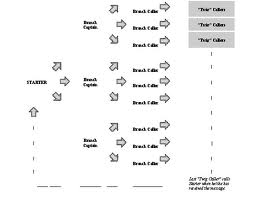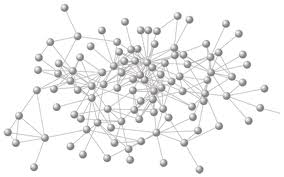


Most groups, when they set up an alert network think of a telephone tree, in which one member, the "Master", sends alert messages to a few other members, who each in turn relay the message to a few others, and so forth until all the members that are reachable are reached. As a check on whether the alert got to everyone, some of those at the ends of the chain are supposed to contact the master or one of his subordinates to confirm receipt. A diagram of such a system might look like this:

|

|

|
The second diagram indicates the problem with a tree topology. If one member cannot be reached, the message doesn't make it to his entire branch. However, the third diagram indicates a way to work around that problem, by having a few links that connect different branches so that if the chain is broken at one member, his downline may still receive the alert.
A more sophisticated topology for an alert network is some variant on a hexagonal grid, illustrated below:

|

|

|
This design allows for many, or perhaps all, of the members to be trusted to initiate alerts, so that the system is not vulnerable to removal of a single master from the system. It is vulnerable to compromise or spoofing of one of the trusted members, so various security measures may have to be set up to avoid this.
In its simplest hexagonal form, each member is only connected to three others. The first initiator contacts his three, who each in turn contact the remaining two connected to them, perhaps excluding any from whom they have already gotten the message, making note of any who cannot be contacted, information that may be relayed to an agreed point for compiling a network status assessment. The topology of the grid is such that eventually everyone who can be contacted will be. By returning the message to everyone to whom one is connected, everyone verifies the message has reached everyone who can be reached, and that it has not become corrupted. No one has to make or receive more than three calls.
The third diagram illustrates a more dense grid, in which everyone is connected to six others. The tradeoff is that the first grid enables faster response time for everyone, since each does not need to call as many, but the second can spread faster if that is a priority.
Many social networks loosely resemble these patterns. A group seeking to set one up may want to try several, and test them under various conditions to discover their weaknesses.
| Home » Defense | |
| Original URL:
http://constitution.famguardian.org/mil/alert_net.htm
Maintained: Constitution Research Original date: 1998/11/21 — |
|